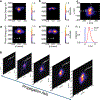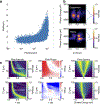Attosecond inner-shell lasing at ångström wavelengths
- PMID: 40500439
- PMCID: PMC12314423
- DOI: 10.1038/s41586-025-09105-9
Attosecond inner-shell lasing at ångström wavelengths
Abstract
Since the invention of the laser, nonlinear effects such as filamentation1, Rabi cycling2,3 and collective emission4 have been explored in the optical regime, leading to a wide range of scientific and industrial applications5-8. X-ray free-electron lasers (XFELs) have extended many optical techniques to X-rays for their advantages of ångström-scale spatial resolution and elemental specificity9. An example is XFEL-driven inner-shell Kα1 (2p3/2 → 1s1/2) X-ray lasing in elements ranging from neon to copper, which has been used for nonlinear spectroscopy and development of new X-ray laser sources10-16. Here we show that strong lasing effects similar to those in the optical regime can occur at 1.5-2.1 Å wavelengths during high-intensity (>1019 W cm-2) XFEL-driven Kα1 lasing of copper and manganese. Depending on the temporal XFEL pump pulse substructure, the resulting X-ray pulses (about 106-108 photons) can exhibit strong spatial inhomogeneities and spectral splitting, inhomogeneities and broadening. Three-dimensional Maxwell-Bloch calculations17 show that the observed spatial inhomogeneities result from X-ray filamentation and that the broad spectral features are driven by sub-femtosecond Rabi cycling. Our simulations indicate that these X-ray pulses can have pulse lengths of less than 100 attoseconds and coherence properties that provide opportunities for quantum X-ray optics applications.
© 2025. The Author(s), under exclusive licence to Springer Nature Limited.
Conflict of interest statement
Competing interests: The authors declare no competing interests.
Figures







References
-
- Hercher M. Laser-induced damage in transparent media. J. Opt. Soc. Am 54, 563 (1964).
-
- Rabi II Space quantization in a gyrating magnetic field. Phys. Rev 51, 652 (1937).
-
- Gray HR, Whitley RM & Stroud CRJ Coherent trapping of atomic populations. Opt. Lett 3, 218–220 (1978). - PubMed
-
- Bonifacio R. & Lugiato L. Cooperative radiation processes in two-level systems: Superfluorescence. Phys. Rev. A 11, 1507 (1975).
-
- Boyd RW, Gaeta AL & Giese E. Nonlinear optics. in Springer Handbook of Atomic, Molecular, and Optical Physics 1097–1110 (Springer, 2008).

